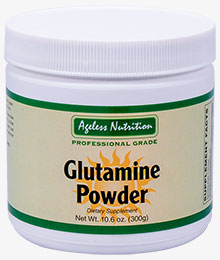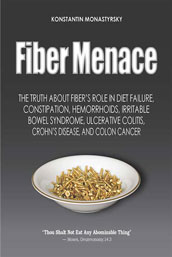Glutamine Powder (L-Glutamine-based Prebiotic)
Pharmaceutical-grade L-Glutamine formula for intensive gastrointestinal recovery and treatment of acute dysbacteriosis. Serves as prebiotic for innate and supplemental flora. Facilitates the healing and integrity of the intestinal mucosal membrane. Robust mucosal membrane is essential for the normal functioning and survival of the intestinal flora.

I‘ve been recommending l-Glutamine-based prebiotics to my readers and clients since 2000 because they stimulates the regrowth of mucosal membrane and improves the retention and survival of intestinal flora on low-fiber diets, and for the functional colorectal disorders discussed on this site.
Healthy intestinal bacteria reside and procreate inside the protective layer of the mucosal membrane, and derive their nutrients from mucus. To give a good home to existing bacteria and provide a head start to supplemental flora, your mucosal membranes must be healthy and well-nourished.
This supplement is manufactured in the United States from pharmaceutical-grade (USP) L-Glutamine.
| 60 Servings per Container | Serving Size: 1 Scoop (5 grams) |
| Amount Per Serving | % Daily value |
| L-Glutamine | 5,000 mg * | |
| * Daily value not established. |
||
| OTHER INGREDIENTS: None | ||
| CONTAINS NO sugar, salt. dairy, yeast, wheat, gluten, corn, soy, preservatives, artificial colors, or flavors. | ||
L-Glutamine is commonly recommended for inflammatory intestinal conditions becaise it facilitates the healing of the mucosal membrane essential for the treatment and/or prevention of pain, bloating, obstruction (due to inflammation), ulceration, bleeding, and possible progression into ulcerative colitis or Crohn‘s disease. The following excerpt from Fiber Menace explains how l-Glutamine accomplishes these goals:

The amino acid glutamine is the principal metabolic fuel for the intestinal mucosa, or, more specifically, for the cells that line the intestinal epithelium (enterocytes). For this reason, the small and large intestines require more glutamine than any other organ.
A deficiency of glutamine causes atrophy of the intestinal mucosa, a condition commonly associated with chronic enteritis, irritable bowel syndrome, ulcerative colitis, and Crohn‘s disease. All of these disorders, in turn, are associated with chronic constipation, something you want to prevent and avoid during the transition [to a low fiber diet - ed.].
Glutamine is readily synthesized in human cells. It is also the most prevalent amino acid in intestinal tissue, blood, skeletal muscles, the lungs, liver, brain, and stomach. When the demand for glutamine exceeds the internal supply—because of trauma, disease, infection, medical treatment, digestive impairment, dietary deficiency, starvation, and similar circumstances—the body must get it from the diet or from supplements. For this reason glutamine is designated as a “conditionally essential” amino acid.
Just like with any other amino acid (except essential), when the diet lacks the adequate amount of protein required to synthesize glutamine, the body draws it from itself. Muscle and bone-wasting (i.e. osteoporosis) is one of the first and most prominent symptoms of acute glutamine deficiency.
Meats, fish, poultry, dairy products, and beans are the main dietary sources of glutamine for people with normal digestion. Because beans cause flatulence and bloating related to their high-fiber content, they are an inappropriate source of glutamine for anyone but the young and healthy.
For people who already suffer from intestinal disorders, regular diets can‘t provide adequate glutamine regardless of the source, because they have difficulties digesting dietary protein to begin with. Ironically, this impasse is caused in part by... glutamine deficiency. There is only one way to break this vicious cycle: by using glutamine in supplemental form.
Glutamine supplements are available in three forms: (1) as L‑Glutamine, a free-form amino acid, which means it‘s identical to the glutamine present in the body; (2) as glutamine peptides, which means it's bound with other amino acids; and as (3) a mix of both.
Glutamine peptides are considered more stable during storage, but are known to cause constipation and bloating, and are contraindicated for people with kidney disease, and women who are pregnant or nursing. For these reasons glutamine peptides aren‘t appropriate for the treatment of constipation and digestive disorders.
There are no known side effects associated with pharmaceutical-grade supplemental L-Glutamine, because, as has been already said, it is identical to naturally-occurring glutamine in the body, and doesn‘t need to be predigested, as glutamine peptides do.
Glutamine supplements are especially popular among athletes and body builders, and are broadly available in health food stores in the form of water-soluble powders, tablets, or capsules. Depending on the degree of intestinal damage, you may require from 5 to 10 g of L-Glutamine daily, hence neither tablets or capsules are practical or economical for this purpose.
Pharmaceutical-grade L-Glutamine is best for supplementation because of its purity and exceptional digestibility (bioavailability). For best results it must be taken on an empty stomach, so it gets down into the intestinal tract without being held up by gastric digestion. Most of the supplements for athletes sold in health food stores contain food-grade L-Glutamine, or are mixed with glutamine peptides.
Fiber Menace, p. 240-242
Glutamine powder is an excellent complement to V.L.C. (very low calories) diets for similar reasons—it prevents protein malnutrition (usually apparent in muscle wasting, bloating, edema, depression, insomnia), and calms down hunger, cravings, and low blood sugar—all the usual diet-breakers. Besides, when the diet is over, you aren't sick, malnourished, and starving, ready to yo-yo back to the old you.
Glutamine powder is particularly useful in critical care nutrition (pre- and post-surgery, severe burns, trauma, gastric bypass, gastectomy, chemotherapy, partial GI obstruction, and similar. In all these instances, critical patients experience a profound need for proteins, but are unable to consume, digest, and assimilate any. I recommend to dissolve Glutamine powder powder in all liquids, including drinking water, broth, tea, coffee, and other beverages. It also works well for children because its practically imperceptible.
This approach prevents gradual wasting of intestinal mucosa and enterocytes (nutrient-absorbing cells), and alleviates acute protein deficiency, typical for clear-liquid diets. This way patients recover faster, experience less secondary side effects, are more resistant to opportunistic infections, and are able to resume normal nutrition as soon as they begin eating solid food, because their GI tract mucous membrane is nearly intact after an extended fast.
Please note that Glutamine powder itself doesn't provide essential amino acids, only L-Glutamine. For long-term critical care nutrition you must also add balanced essential amino acid liquid formulas, such as Pro-Stat 64 or Twinlab's AminoFuel.
How to take Glutamine powder
Take one scoop (provided inside the container) of Glutamine powder with half-a-glass of plain water. You can take it before, with, or after food. It dissolves quickly and easily in warm fluids, and despite L-Glutamine being an amino acid, the solution itself is only mildly, almost non-perceptibly, acidic, and mild on the stomach.
Taking Glutamine powder along with Hydro-C program is perfectly fine. Just don't mix both in the same glass because you do need extra water to assimilate these supplements and to offset the loss of fluids with stools when using Hydro-C program as a softener and moisturizer.
Critical care patients may take Glutamine powder round-the-clock with all liquids. Always consult an attending doctor before giving this or any other supplement to a patient. If the doctor tells you not to provide it, always ask why. Some physicians may dismiss your request simply because they may be too busy to investigate it. In this case seek a second opinion or appeal to supervising staff.
This information has not been evaluated by the Food and Drug Administration. This product is not intended to diagnose, treat, cure or prevent any disease.
